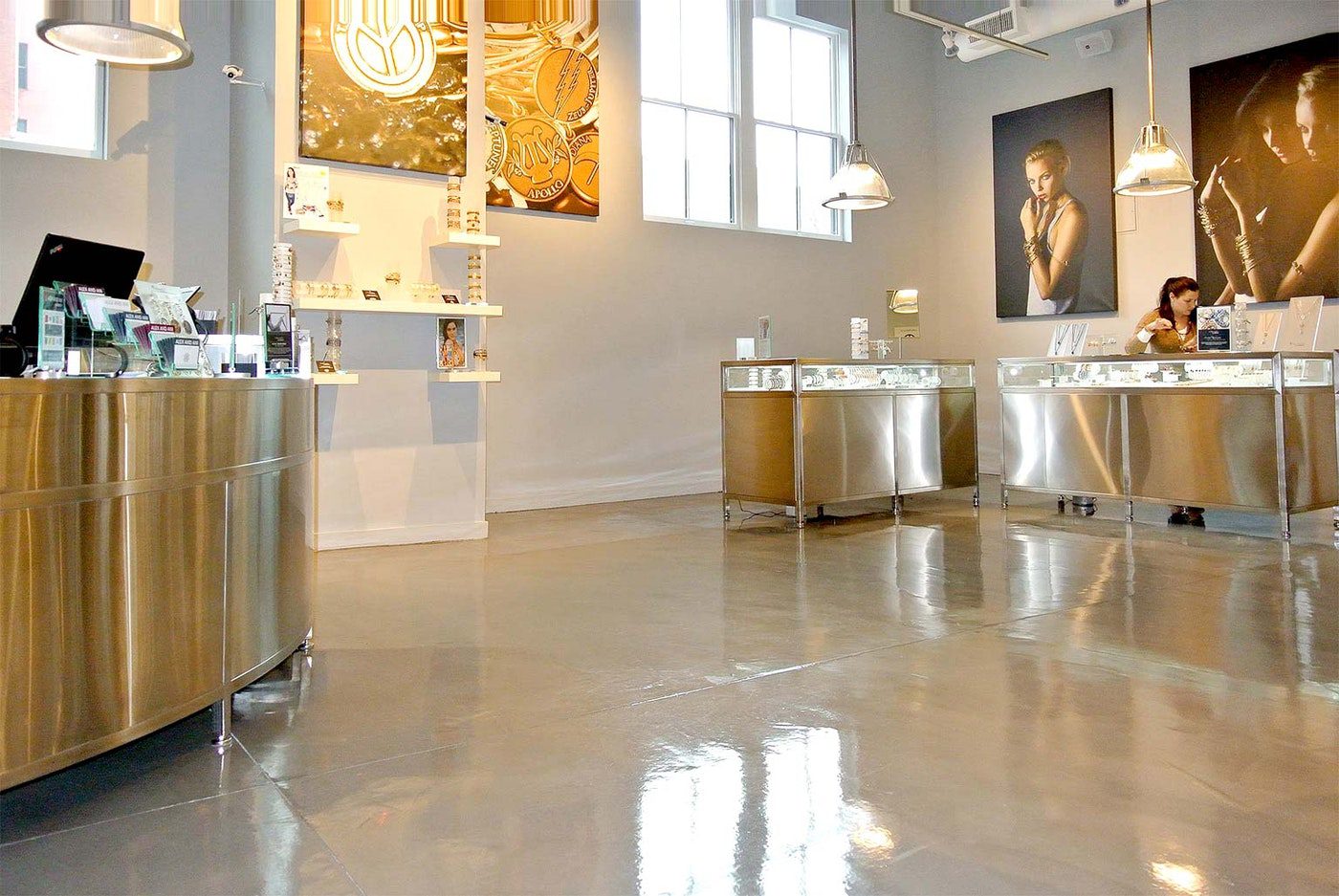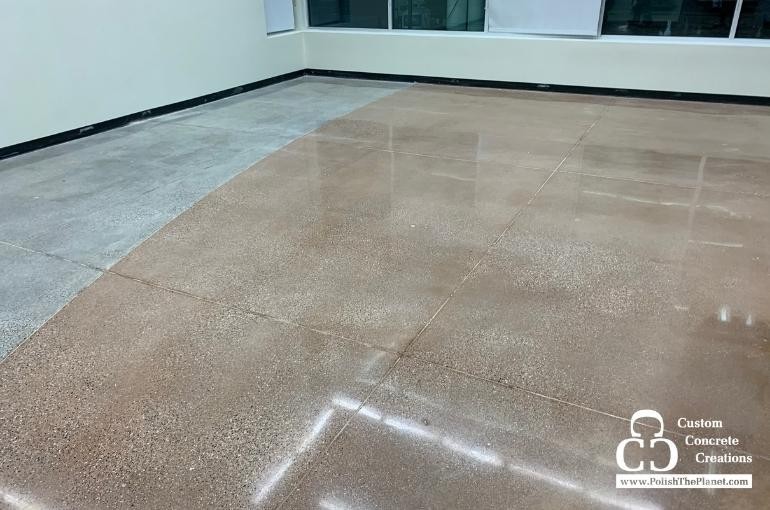Comprehensive Guide to the Services Used in Polished Concrete Floor Covering Installation
Polished concrete flooring installation includes numerous essential services that add to a durable and visually enticing finish. The process starts with thorough surface area prep work, ensuring the concrete slab is tidy and without imperfections. Following this, grinding and sharpening methods are used to accomplish a smooth surface. The trip doesn't finish there. Recognizing the numerous alternatives for tinting, sealing, and maintenance can significantly affect the last outcome and longevity of the flooring.
Surface Area Prep Work Strategies
Prior to setting up polished concrete flooring, correct surface prep work is essential to ensure a long lasting and cosmetically pleasing surface. This initial phase entails several vital actions that confirm the substrate appropriates for the overlay. Any existing flooring coverings, such as carpeting or tile, have to be eliminated to reveal the concrete piece - Polished Concrete Austin Tx. Next off, the surface should be completely cleansed to eliminate dirt, grease, and various other contaminants that can hinder bond
Additionally, reviewing the problem of the concrete is vital; fractures, imperfections, and surface area irregularities have to be addressed. This may include patching or leveling to produce an uniform base. Dampness screening is also advised, as excess moisture can bring about future difficulties. Using a guide can improve adhesion between the concrete and the brightened surface. By following these surface area prep work strategies, the durability and appearance of the polished concrete flooring are considerably enhanced.
Grinding and Refining Processes
When the surface preparation is full, the grinding and refining processes play a crucial function in achieving a premium polished concrete coating. Grinding involves the use of specialized diamond-embedded tools to eliminate any kind of surface imperfections and accomplish a degree surface. This procedure is important for exposing the concrete aggregate, which contributes to the flooring's visual allure.
Developing follows grinding and entails finer diamonds to produce a smoother surface area. This phase boosts the concrete's appearance and prepares it for succeeding sprucing up. The grit degrees utilized during sharpening are carefully picked to assure a refined finish without compromising the honesty of the concrete.
Both grinding and developing call for experienced drivers who recognize the subtleties of the concrete surface area and can change methods according to details task needs. Appropriate implementation of these procedures considerably impacts the longevity and visual top quality of the final polished concrete floor.
Polishing Methods and Tools
A number of reliable brightening approaches and customized equipment are utilized to achieve a high-gloss finish on concrete floorings. One of the most common technique includes using ruby polishing pads, which are available in differing grits. These pads are mounted on floor brightening devices that systematically grind the surface area to the wanted luster.
Wet polishing is favored for its ability to reduce dirt and reduce warmth, while completely dry sprucing up is liked for its efficiency in smaller sized rooms. Furthermore, worldly floor mills are usually utilized as they give also pressure and speed, making sure uniform results.
Advanced equipment may include automated or remote-controlled equipments, which enhance performance and lower labor strength. Eventually, choosing the appropriate brightening technique and equipment is essential for accomplishing the wanted finish and longevity of the polished concrete flooring, satisfying both aesthetic preferences and functional demands.
Coloring and Staining Alternatives

Discoloring Techniques Introduction
Exploring various discoloration techniques can substantially boost the visual appeal of polished concrete floor covering. Discoloring options drop into 2 main groups: acid-based and water-based discolorations. Acid stains respond chemically with the concrete, producing abundant, variegated shades that imitate all-natural rock. They permeate deeply, causing a resilient surface. In contrast, water-based stains offer a broader spectrum of shades and are less complicated to apply, providing a much more consistent appearance. Furthermore, concrete dyes can achieve lively tones and are commonly made use of along with spots for added depth. Each strategy can drastically change the visual features of the surface, enabling customization that fulfills particular style choices while guaranteeing a special, innovative look in any kind of space.
Color Options Available
A diverse scheme of color options is readily available for boosting polished concrete floor covering with staining and dyeing techniques. These techniques allow for a variety of tones, from earthy tones to lively shades, providing house owners and companies the adaptability to match their visual choices. Acid-based stains react chemically with the concrete, creating a variegated appearance that simulates all-natural stone. In comparison, water-based discolorations provide an extra consistent shade and are offered in a broader range of tones - Polished Concrete Austin. Dyes can also be made use of to achieve bold, intense colors, permitting elaborate layouts and patterns. Each choice adds to the overall result and longevity of Polished Concrete Floors Austin the floor covering, making color option a necessary consideration in polished concrete installation
Modification and Impacts
While considering polished concrete flooring, modification options for tinting and tarnishing play an important duty in attaining distinct appearances. Property owners and organizations can pick from a diverse palette of shades, enabling customized styles that suit their certain tastes and environments. Discoloring methods, including acid and water-based choices, enhance the natural appeal of concrete while offering a sturdy surface. Acid discolorations develop abundant, variegated hues, while water-based discolorations offer a broader variety of colors and are more eco friendly. Furthermore, attractive effects such as metal coatings or color overlays can add deepness and aesthetic rate of interest. This degree of personalization assurances that polished concrete floor covering not just satisfies useful demands however additionally matches the general design vision of the space.
Securing and Protecting the Surface
Sealing polished concrete is important for improving toughness and stopping damages from discolorations and moisture. Various types of sealants are readily available, each offering one-of-a-kind advantages and protection degrees. Recognizing these alternatives is important for keeping the stability and look of the flooring.
Value of Sealing
The longevity and visual charm of polished concrete flooring significantly depend on the application of a premium sealer - Austin Polished Concrete. Sealing serves several objectives, primarily shielding the surface area from discolorations, dampness, and abrasion. By forming a barrier, sealers prevent the infiltration of liquids and chemicals, which can trigger staining and destruction gradually. This protective layer likewise boosts the shine and visual deepness of the concrete, adding to its total charm. Additionally, proper securing reduces maintenance needs, making it easier to clean and keep the floor's appearance. Frequently sealed concrete floors display enhanced sturdiness, guaranteeing they stand up to hefty foot traffic and withstand wear. Ultimately, securing is an important step that substantially impacts the efficiency and life-span of polished concrete flooring
Sorts of Sealers
Choosing the appropriate kind of sealer is crucial for maintaining the stability and appearance of polished concrete flooring. There are mainly two groups of sealants: penetrating sealers and topical sealants. Passing through sealants, frequently silicone or silane-based, infiltrate the concrete, supplying security against wetness and discolorations while allowing the surface area to breathe. In contrast, topical sealers, such as acrylic or epoxy, create a protective movie externally, improving gloss and shade while providing an obstacle against wear and chemicals. Each kind has its benefits; passing through sealants are ideal for high-traffic areas, while topical sealers provide a more visual finish. Eventually, the option of sealant depends upon the particular needs and planned use of the polished concrete floor covering.
Maintenance and Look After Polished Concrete
Appropriate upkeep and treatment are important for extending the life expectancy and charm of polished concrete flooring. Routine cleaning is a key need; making use of a pH-neutral cleaner and a microfiber wipe will efficiently remove dirt and grime without harming the surface area. Stay clear of making use of harsh chemicals that can plain the coating.

Cleaning and brushing up should occur often to avoid scrapes created by particles. Making use of furnishings pads can also reduce potential damage from heavy items.
Regular professional upkeep can aid recognize any kind of problems early and recover the surface to its original gloss. By adhering to these care standards, polished concrete floor covering can continue to be an appealing and resilient choice for many years to come.
Expense Considerations and Budgeting Tips
While intending for polished concrete flooring setup, it's essential to examine different price factors that can impact the total budget plan. The key expenses include materials, labor, and any kind of essential site prep work. The kind of surface picked-- such as matte, gloss, or attractive-- also significantly affects costs. In addition, the dimension and problem of the room will certainly affect both the amount of concrete required and the complexity of the installation.
To handle expenditures successfully, obtaining multiple quotes from specialists is a good idea. This enables contrasts of solutions and pricing. House owners should also take into consideration concealed prices, such as possible repairs to existing floor covering or the requirement for customized equipment, which can add to the overall expenditure.
Reserving a contingency fund for unexpected expenses can even more guarantee economic readiness. By taking these budgeting ideas into account, one can achieve a polished concrete flooring that satisfies aesthetic and practical needs without exceeding the budget.
Frequently Asked Concerns
Exactly how Lengthy Does the Entire Setup Refine Take?
The installment procedure period Check This Out can differ based upon task dimension and complexity. Commonly, it ranges from a few days to a week, incorporating surface area prep work, grinding, from this source brightening, and sealing phases for suitable lead to polished concrete flooring.
Can Polished Concrete Be Set Up Outdoors?
Polished concrete can without a doubt be mounted outdoors, as it supplies toughness and aesthetic appeal. However, correct sealing is essential to protect against weather condition aspects, ensuring durability and preserving its visual integrity in exterior atmospheres.
What Kinds of Structures Appropriate for Polished Concrete?
Polished concrete appropriates for various buildings, including property homes, industrial spaces, stockrooms, and commercial facilities. Its longevity and aesthetic appeal make it a suitable option for high-traffic locations and environments needing low maintenance.
Is Polished Concrete Slippery When Wet?
The question of whether polished concrete becomes unsafe when damp prevails. While it can be slick, the degree of slipperiness commonly depends on the finish and appearance applied during installment, affecting safety in different settings.
Can I Mount Polished Concrete Over Existing Floor Covering?
The feasibility of mounting polished concrete over existing flooring relies on the type and problem of the underlying surface area. Proper evaluation and prep work are necessary to ensure bond and accomplish a resilient, visually pleasing surface.